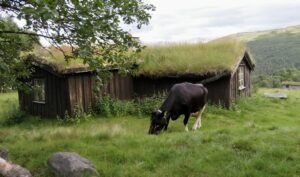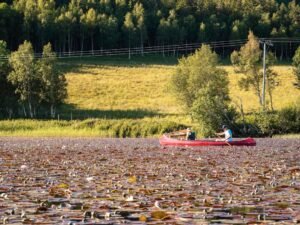

Color and Design: Learning Norwegian Expressions for Colors and Patterns
Colors and patterns are not just core elements of art and design; they also play an essential role in our daily lives. Whether you’re choosing clothes, decorating a room, or discussing art pieces, understanding how to accurately describe colors and patterns in Norwegian will allow you to communicate with confidence in various settings. In this article, we will explore how to express colors, patterns, and design-related terms in Norwegian, helping you better understand and use these words in your conversations and design discussions.
Learning these words not only enhances your ability to describe visual elements but also improves your professional and personal communication skills. If you’re interested in expanding your knowledge of the Norwegian language, particularly in design and artistic contexts, sign up for Norwegian classes at NLS Norwegian Language School. Our courses will provide you with an excellent learning experience tailored to your needs.
Table of Contents
Toggle1. Basic Norwegian Color Vocabulary
Colors are an essential part of our daily lives, influencing our emotions and perceptions from the clothes we wear to the environments we inhabit. In Norwegian, learning common color vocabulary is the foundation for understanding and expressing yourself.
1. Primary Colors (Primærfarger)
- Rød – Red
Example: Blomsten er rød.
(The flower is red.) - Blå – Blue
Example: Himmelen er blå i dag.
(The sky is blue today.) - Gul – Yellow
Example: Solen er gul.
(The sun is yellow.)
2. Secondary Colors (Sekundærfarger)
- Grønn – Green
Example: Grønne trær omgir oss.
(Green trees surround us.) - Oransje – Orange
Example: Hun har på seg en oransje genser.
(She is wearing an orange sweater.) - Lilla – Purple
Example: Sofaen er lilla.
(The sofa is purple.)
3. Neutral Colors (Nøytrale farger)
Neutral colors are widely used in design, fashion, and home decor to create balance and sophistication.
- Svart – Black
Example: Bilen er svart.
(The car is black.) - Hvit – White
Example: Vinduene er hvite.
(The windows are white.) - Grå – Gray
Example: Veggene er malt i en lys grå farge.
(The walls are painted in a light gray color.)
These basic colors are not only widely used in everyday conversations but also frequently appear in the fields of fashion, design, and art. Knowing these terms will allow you to more naturally describe and discuss color features in different objects.
2. Describing Shades and Tones of Colors
In Norwegian, you can further describe colors by adding modifiers that indicate the shade, tone, or brightness of the color. Here are some common ways to describe various aspects of colors:
1. Light and Dark Colors
- Lys – Light
Example: Jeg liker lys blå mer enn mørk blå.
(I prefer light blue to dark blue.) - Mørk – Dark
Example: Han har på seg en mørkeblå jakke.
(He is wearing a dark blue jacket.)
2. Brightness and Saturation
- Sterk – Bright
Example: Fargen på veggene er veldig sterk.
(The color of the walls is very bright.) - Matt – Matte
Example: Jeg foretrekker en matt finish på møblene.
(I prefer a matte finish on the furniture.)
These words help you add more detail to your descriptions, making it easier to explain exactly how a color appears, which is especially useful in design, fashion, or art discussions.
3. Common Patterns in Norwegian
Patterns are another essential element of design, adding texture and character to objects. In Norwegian, several words can be used to describe common patterns that appear in textiles, clothing, and home decor.
1. Stripes (Striper)
Striper refers to stripes, a common pattern found in fashion, home decor, and textiles.
Example: Kjolen hennes har blå og hvite striper.
(Her dress has blue and white stripes.)
2. Plaid (Ruter)
Ruter refers to plaid or checkered patterns, which are often found on shirts, tablecloths, and blankets.
Example: Jeg kjøpte en rød og svart rutete skjorte.
(I bought a red and black plaid shirt.)
3. Polka Dots (Prikker)
Prikker means polka dots, a playful and classic pattern often seen in fashion and accessories.
Example: Den nye puten har små hvite prikker.
(The new pillow has small white polka dots.)
4. Floral Patterns (Blomstermønster)
Blomstermønster refers to floral patterns, which are common in women’s fashion and fabric design.
Example: Teppe har et vakkert blomster mønster.
(The rug has a beautiful floral pattern.)
5. Abstract Patterns (Abstrakte mønstre)
Abstrakte mønstre are abstract patterns that are often used in modern art and design, featuring irregular or free-form shapes.
Example: Maleriet på veggen har abstrakte mønstre.
(The painting on the wall has abstract patterns.)
Learning these pattern-related terms will help you better describe objects or design elements, allowing you to engage more fluently in artistic, fashion, or design-related conversations.
4. Describing Design Styles in Norwegian
In addition to colors and patterns, knowing how to describe design styles is crucial for anyone interested in art, fashion, or interior design. Below are some common adjectives and expressions to help you talk about design in Norwegian.
1. Modern (Moderne)
Moderne refers to modern, contemporary design, often characterized by clean lines and minimalist aesthetics.
Example: Vi har et moderne kjøkken med minimalistiske møbler.
(We have a modern kitchen with minimalist furniture.)
2. Traditional (Tradisjonell)
Tradisjonell describes classic or vintage design, often associated with historical or cultural roots.
Example: Dette huset har en tradisjonell norsk stil.
(This house has a traditional Norwegian style.)
3. Simple (Enkel)
Enkel means simple, unadorned design, often used to describe minimalist or straightforward design.
Example: Jeg foretrekker enkle og rene linjer i designet.
(I prefer simple and clean lines in design.)
4. Elegant (Elegant)
Elegant is used to describe sophisticated, refined design, often seen in fashion and interior decor.
Example: Hennes kjole er både enkel og elegant.
(Her dress is both simple and elegant.)
5. Vibrant (Fargerik)
Fargerik means colorful and lively, used to describe designs or art pieces with rich, vibrant colors.
Example: Maleriet er veldig fargerikt og energisk.
(The painting is very colorful and energetic.)
These adjectives will help you describe design styles with more precision and depth, allowing for more insightful discussions about art and design.
5. Using These Words in Conversations and Writing
Once you have mastered these vocabulary words related to colors, patterns, and design, you will find it much easier to engage in conversations about fashion, home decor, or art. Whether you are shopping for furniture, discussing a design project with a professional, or simply chatting with friends about fashion, these words will enable you to express yourself confidently.
In conversations, you can use these words to describe the colors you like, the patterns in your home, or the designs you admire. In writing, these terms will help you compose essays, articles, or descriptions related to design and visual arts.
If you want to further improve your Norwegian language skills and learn how to use these expressions effectively, especially in professional or creative contexts, sign up for Norwegian classes at NLS Norwegian Language School. Our courses are designed to help you master the language in a structured way, providing comprehensive lessons tailored to your goals.
Conclusion
Learning Norwegian expressions for colors and patterns not only allows you to discuss design, fashion, and art with more confidence but also enhances your ability to describe everyday objects and environments. By mastering these words, you’ll be able to better express your personal style and design preferences, as well as engage in creative discussions with others.
Whether you’re a designer, student, or simply interested in learning Norwegian, these words will serve as valuable tools. Keep practicing and incorporating them into your daily conversations and writing, and you’ll find yourself more fluent in both Norwegian and the language of design!
If you want to learn Norwegian, you can register for classes here. We look forward to hearing from you and helping you become fluent in Norwegian.





